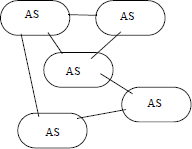Chapter 12
External Routing Protocols

12.1. Path announcing
12.1.1. Principles
Routers make their routing decision based only on the destination address in a packet’s header and the information on the routing table. In the domain, the choice of a path is not important as any path is better than a loss of connectivity. A configuration error in a router can be propagated and compromise the connectivity. For routing among domains, the policy is different. It is very important to maintain the global connectivity of the Internet, so the configuration of a router is important. It needs to take into account the rules between service providers in order to choose one path over another. Thus, it must not be possible to send packets to a destination through a third party organization’s site, even though this is the better solution.
Figure 12.1 shows the importance of the external routing protocols. The network has three ASs (autonomous systems); each one deploys internal routing policies that allow the edge routers to know the network addresses corresponding to each system.
The zone edge routers broadcast this information to the other domains using external routing protocols. The internal routing protocol will in its turn transmit this information to the other routers in the system. So the stations of AS2 will send the data concerning AS1 stations to router 3, and the data of AS3 to router ...
Get Local Networks and the Internet: From Protocols to Interconnection now with the O’Reilly learning platform.
O’Reilly members experience books, live events, courses curated by job role, and more from O’Reilly and nearly 200 top publishers.

